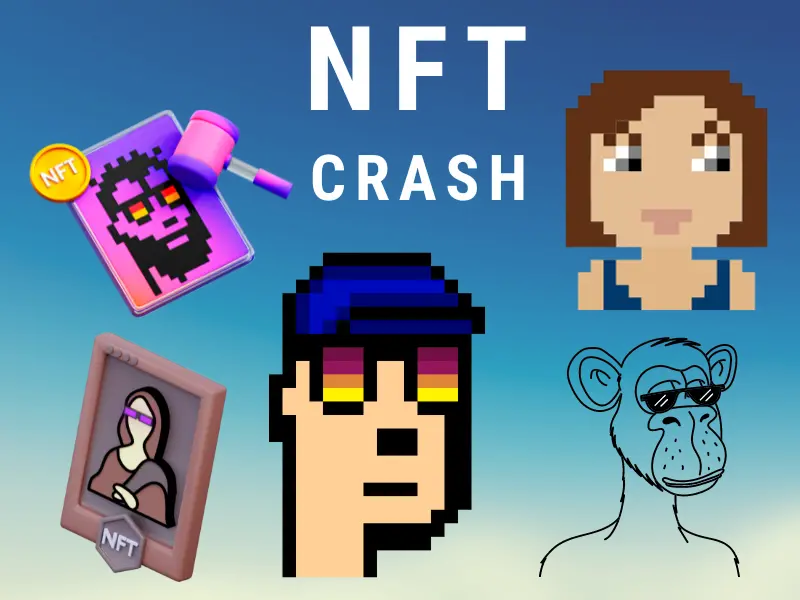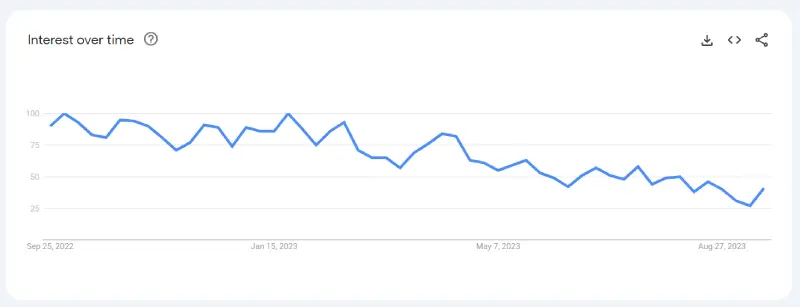
Non-fungible tokens (NFTs) took the world by storm in 2021. These digital assets representing ownership of unique virtual items like crypto art saw enormous hype, with some selling for millions of dollars. But data now shows that the vast majority of NFTs have crashed in value, leaving many investors holding essentially worthless JPEGs. What happened to cause the great NFT crash?
The NFT Bubble
In early 2021, NFT trading volume exploded, growing from just $8 million in January to over $2 billion by May. High profile sales like Beeple’s $69 million dollar NFT at Christie’s auction house brought mainstream attention. Suddenly it seemed everyone wanted to get in on the NFT gold rush.
The assumption was that NFTs would continue appreciating in value, allowing buyers to “flip” their assets for big profits. But this was largely based on hype and speculation, not an underlying use case. While some brands and artists released limited edition NFTs that sold out quickly, the actual utility of owning most NFTs was unclear.
Supply Floods the Market
Seeing the euphoria around crypto art in 2021, many creators rushed to mint their own NFT collections and cash in. Marketplaces like OpenSea made launching NFTs easy.
But this flood of supply far outpaced real demand. A recent study found 79% of NFTs remain unsold. Out of over 70,000 collections examined, 95% are now valued at zero.
With so many NFTs and so few buyers, sale prices plummeted. The average price for top collections is now just $5 to $100. The NFT market became oversaturated, and most new projects had no chance of succeeding.
The Crypto Crash Sinks NFTs
NFT mania was fueled by abundant liquidity and loose monetary policy during the pandemic recovery. But as central banks hiked rates to curb inflation, risky assets like cryptocurrencies got crushed.
Bitcoin has lost 60% of its value since its November 2021 peak. The crypto market downturn massively slowed NFT trading activity. Monthly sales volume dropped from nearly $5 billion in January 2022 to under $500 million by September.
With cryptos like Ethereum plunging, NFTs lost their luster for speculators. And since NFTs are priced in ETH, their dollar values dropped in tandem with Ethereum’s slide.
Lack of Regulation Exposes Scams
The NFT space was rife with scams, fakes, and pump and dump schemes during the boom times. A lack of regulation enabled grifters to take advantage of the NFT hype.
For example, the breakout hit NFT collection Azuki was exploited when hackers impersonated the project creators and stole $1.6 million worth of NFTs from a “mintpass” presale. These scams made collectors wary of buying lesser known NFTs.
Meanwhile, “rug pulls” by anonymously launched projects whose founders disappeared after the mint left buyers holding worthless JPEGs. As stories of fraud spread, faith in the legitimacy of new NFT drops diminished.
Opensea Interest Declines

The fading interest in NFTs is evident not just in falling sales volumes and prices, but also in declining Google search traffic for once hot terms like “OpenSea.”
OpenSea is the largest NFT marketplace, but data from Google Trends shows that searches for the platform have steadily declined over the past 12 months.
In January 2022, OpenSea hit a peak popularity score of 100 on Google Trends. By September 2022, its score had dropped to just 8, indicating searches were down 92% from peak levels. This plunge in search interest for the largest NFT trading hub mirrors the overall slowdown in NFT mania as speculation has dried up.
The OpenSea hype cycle followed the classic arc of rapid acceleration in interest followed by a sharp comedown.
Ongoing Struggles for Utility
A key criticism of NFTs is that they don’t inherently have utility beyond trading speculation. Some NFT bulls argue they could represent ownership in the metaverse, games, social clubs, events, or even fractionalized physical assets.
But these conceptual use cases have been slow to materialize. The average person does not derive any benefit from owning most NFTs. And with prices crashing, interest in showing off flashy NFT profile pics has waned.
Proponents argue NFTs just need more time to develop real utility. But for now, the lack of obvious practical value for most NFTs makes them a very hard sell.
Whats Next
The great NFT crash has been an abrupt comedown after the extraordinary hype of 2021. For the NFT market to recover, it needs to move beyond speculation toward more fundamental utility. Until then, digital collectibles will likely remain poor investments for the vast majority of buyers. But the advent of NFTs has still accelerated the ownership transition toward more digitally native creative works.
The boom and bust of NFTs follows a classic speculative bubble trajectory. And like with previous manias such as the 1990s dot-com bubble, the underlying technology may still create value after the hype dies down.
While the current NFT market faces a harsh freeze, proponents believe non-fungible tokens could still revolutionize content creation, ownership and monetization. What might a more sustainable NFT ecosystem look like?
Better Discoverability for Quality Projects
The present NFT market is fragmented across multiple blockchains and marketplaces. This makes it hard for buyers to identify solid projects vs. low effort cash grabs.
Better aggregation platforms that curate and review NFT collections could improve discoverability. Features like verified creators, community strength metrics and due diligence checks could assist buyers.
Building Trust Through Reputation
Right now most NFT creators are pseudonymous. But attaching real world identities via verification could build more trust and accountability.
Platforms that foster interactions between NFT creators and owners also nurture engagement. Long-term value stems from active communities, not just flipping for profit.
Expanding Utility and Accessibility
NFTs need more hooks that make ownership feel meaningful beyond just financial speculation. Integrating NFTs into games, social networks, web3 sites and metaverse worlds can demonstrate practical applications.
Reducing the barriers to purchasing, storing and displaying NFTs also expands the potential audience. As wallets, exchanges and NFT galleries improve their interfaces, mainstream adoption could grow.
The NFT revolution still faces obstacles. But if developers address flaws in current market infrastructure and design, non-fungible tokens could emerge as more than just a fleeting fad. With meaningful utility and reduced speculation, NFTs may yet transform how digital creations are owned and valued.
Conclusion
Like many others, I got caught up in NFT hype last year. I wanted to be part of the excitement around these digital assets and saw friends making money flipping NFTs. So I spent around $5,000 buying several NFTs from top collections, hoping to sell them later for a profit. One year later, my NFTs are practically worthless. What went wrong?
At first, collecting NFTs was thrilling. Every new drop felt like a fun game where you tried to mint something cool that would catch on. The communities on Discord were lively, discussing price actions and showing off new acquisitions. Owning a blue-chip NFT gave you social clout and status.
But the constant barrage of new projects eventually all started blending together. Mediocre derivative art was getting scooped up purely out of FOMO. It became exhausting trying to keep up with new launches and figuring out which might moon.
My first reality check came when I tried selling one of my NFTs on OpenSea for 25% below the floor price and got zero takers. There just wasn’t demand for this collection anymore. Its value had vanished into thin air.
That’s when I realized prices were almost entirely speculative. These images I’d paid good money for had no intrinsic worth. They generated no income. The communities died down. Worst of all, I simply didn’t enjoy them as much. Staring at my expensive bored ape felt unsatisfying.
When the crypto market crashed, NFT prices plummeted across the board. Now my NFTs are worth a small fraction of what I paid. I’ll be lucky to get $500 for my whole collection that I dropped thousands on.
While NFTs are an innovative technology, actually owning them provided little tangible utility. I got caught up in the excitement of it all without considering long-term fundamentals. For me, the NFT novelty has worn off, and I don’t plan on buying more. The crash has left a bitter taste behind for many users like myself.



